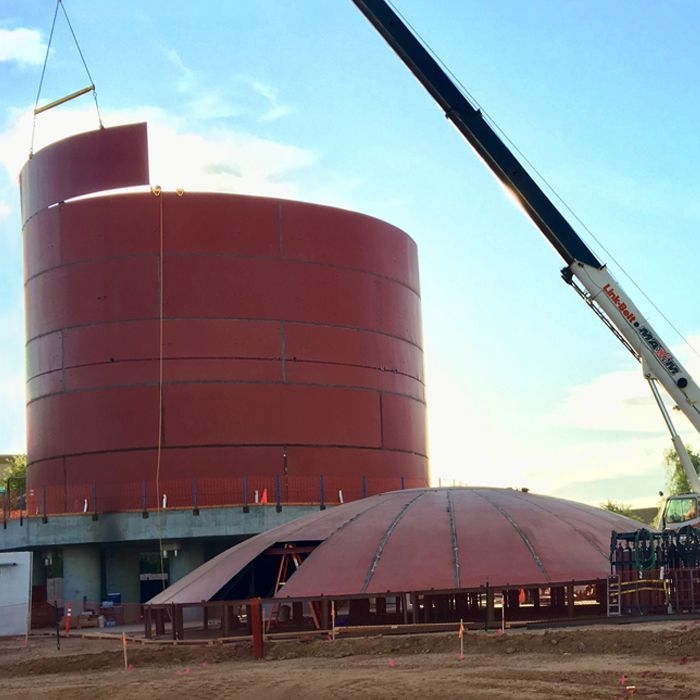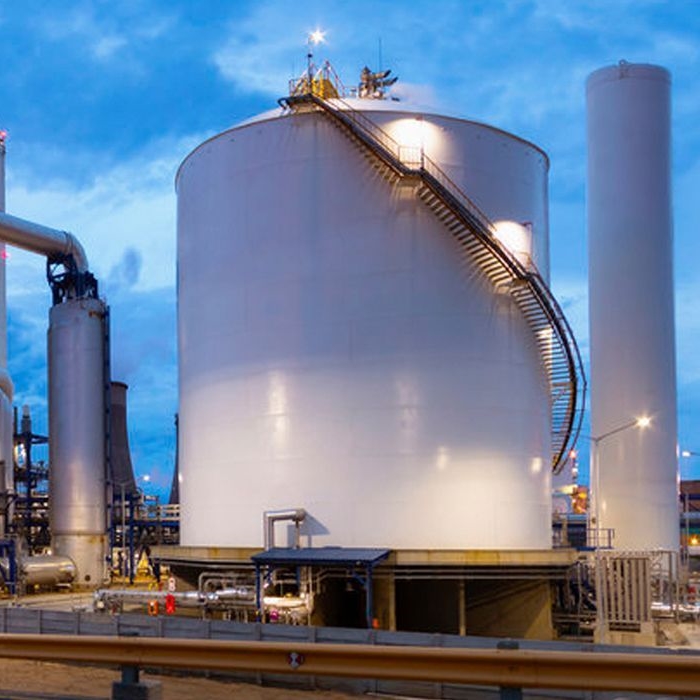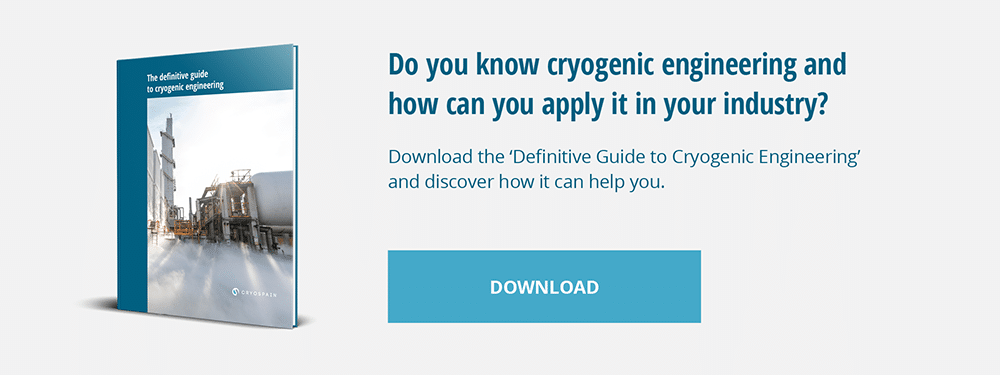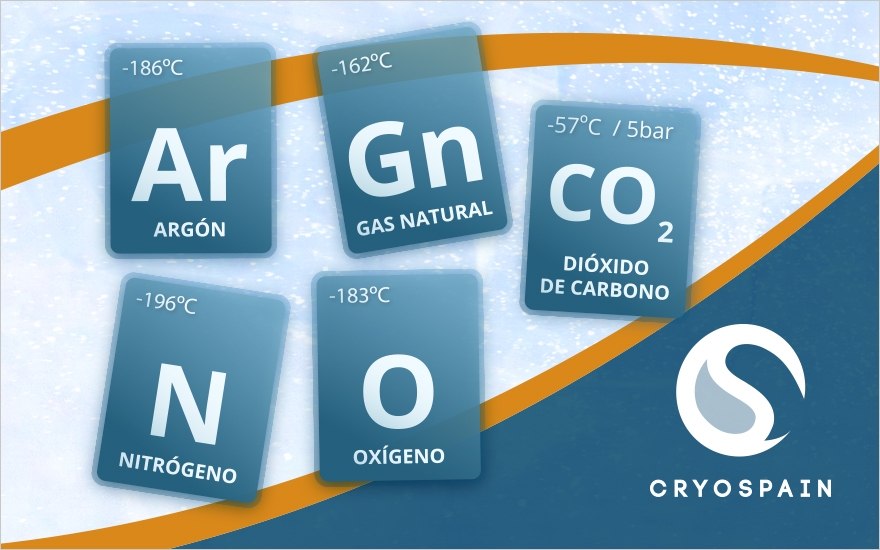Knowing what cryogenic liquid gases are and the different types that exist is essential in order to properly grasp their different uses and storage systems.
What is a cryogenic liquid gas?
These are gases that are cooled to liquid form. This enables them to be safely transported in non-pressurised state and to be stored.
When defining cryogenic liquefied gases, it should also be noted that they are odourless, colourless, non-toxic and non-corrosive substances. Their main hazards are flammability after vaporisation, freezing and asphyxiation by inhalation.
How are cryogenic liquid gases contained?
Cryogenic liquefied gases are transported in different thermally insulated containers, which are specially designed to withstand the rapid and extreme temperature changes to which they are subjected. These containers include:
Dewar flasks are non-pressurised containers, with a loose lid or stopper that serves a dual function; to prevent the entry of air and moisture and, at the same time, to ensure venting of excess pressure. Liquid Dewars for laboratories, on the other hand, have no cover, and are mainly used for temporary storage.
Liquid cylinders are pressurised containers used for cryogenic liquids. They have a valve for filling and dispensing the liquid, and another for pressure control. They can be for gas only, liquid only or both.
Related content: Latest advances in cryogenic engineering: where is the industry headed?
Everything you should know about the main liquid gases
Each of the liquefied gases has its own specific characteristics, but we can fit them into one of these main groups:
· Inert gases, which do not react chemically for the most part, such as helium or nitrogen.
· flammable gases, which can burn in air, such as hydrogen or liquefied natural gas
· Liquid oxygen, in the presence of which some organic materials may burn or explode.
LNG: Liquefied Natural Gas
What is LNG? It is natural gas that has undergone a liquefaction process for safe and economical transport and storage. It contains 95% methane, which is the cleanest fossil fuel.
It is sourced from countries such as Algeria, Norway, Qatar, Russia, Nigeria and the United States. LNG has a wide range of uses across industry, transport and household applications, but first it must be transported. The most economical choice for this are tankers, which means the natural gas must undergo a refrigeration cycle that converts it to its liquid form.

Discover one of our projects: LNG flat bottom cryogenic tank in Santa Cruz de la Sierra (Bolivia).
LIN: Liquid Nitrogen
Liquid nitrogen is odourless, colourless, non-toxic, non-flammable and relatively inert. It is also slightly lighter than air at room temperature. It is stored in special containers, vented to prevent pressure build-up.
Uses of liquid nitrogen include freezing and transporting food, cryopreservation of biological samples, refrigeration for superconductors, and cryotherapy treatments for skin.

Take a look at one of our projects: LIN Flat bottom cryogenic tank in Chandler, Arizona (EEUU).
LOX: Liquid Oxygen
Liquid oxygen is extremely cold and has a high oxidising power, although it is not flammable. It is a liquid that requires special equipment for handling and storage, such as cryogenic storage tank.
The uses of Liquid oxygen are huge across multiple sectors, for example: medical and pharmaceuticals industries, aerospace industry, steel manufacturing,chemical industries and many more.

Discover one of our projects: LOX flat bottom cryogenic tank in Secunda (South Africa).
LAR: Liquid Argon
Argon is a noble gas, colourless, odourless and inert to other substances. Although used more commonly in the gaseous state, argon is frequently stored and transported as a liquid, affording a more cost-effective way of providing product supply.
It provides an atmosphere that prevents welded metals from rusting. Its main uses include health care treatments, lighting and the food industry, among others. It is also one of the most widely used scintillators in particle detection, because of its high availability, low cost and excellent scintillation properties.
LCO2: Liquid Carbon Dioxide
Liquid carbon dioxide is odourless and colourless, and is known for its stability under normal circumstances. Its properties make it an indispensable element in sectors such as electronics, the chemical industry and, especially, the food industry.
In this industry, it acts as a food preservative, used to preserve, refrigerate, store and soften. Solvent extraction using compressed liquid CO can be used in industrial processes such as removing caffeine from coffee or improving the yield of olive oil production.
You may like: LCO2 Vaporizer: adaptable high engineering
Working with liquid gases
Any professionals working with liquefied gases, such as LIN, LOX and LAR, should be aware of the hazards that may be associated with their handling. Essentially, the associated risks are:
· Extreme cold, which can produce thermal burn-like effects and even frostbite in the case of prolonged exposure.
· Also, when these liquids form a gas, it is very cold and usually heavier than air. This means that it can accumulate and, in the event of a lack of oxygen, can lead to asphyxiation.
· Finally, it should be borne in mind that each of these gases can have specific toxic effects on health.
At Cryospain we are leaders in the supply of storage and distribution solutions for cryogenic liquid gases. We are reconginsed in our sector for the design, manufacture and maintenance of cryogenic equipment and installations. Our professionals work to adapt to the needs of our clients by applying innovative procedures that allow us to supply them with customised cryogenic tanks.











 Contacte-nos
Contacte-nos